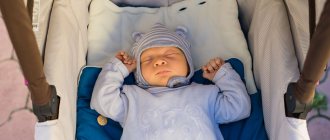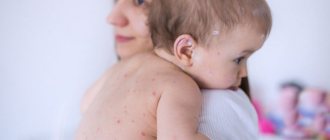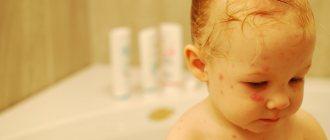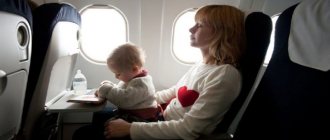Against the background of acute respiratory infections or acute respiratory viral infections, children often develop a cough. It is caused by inflammation of the upper or lower respiratory tract. Cough can also be of an allergic nature and require specific treatment. Parents who are worried that the child’s body lacks fresh air during illness try to walk with the child when he has a cough. However, with any cough, you must first show the child to the doctor to find out the seriousness of the disease, and only then solve the problem of walking outside.
Types of cough for which you can walk with your child
There are two types of cough: wet and dry. The first differs from the second in that it releases sputum accumulated in the respiratory tract. As for walking, you can walk even if you have a dry or wet cough. If you approach the issue correctly, then thanks to being in the fresh air, a dry cough will quickly turn into a productive one, and a wet cough will soon disappear altogether. The same principle applies to coughs caused by allergic reactions, but in this case you need to make sure that there is no irritant (pollen, fluff) outside the house and give the child an antihistamine in advance.
Benefits of fresh air for coughs
Cold fresh air during a cold has the following beneficial functions:
- normalizes breathing and makes it deeper,
- promotes thinning of sputum and better removal of mucus,
- improves blood supply to the bronchi,
- hardens the mucous membrane of the throat and nose,
- activates mucus production.
In addition, during movement, the organs of the respiratory system are more actively supplied with oxygen, which is useful for a speedy recovery. And thanks to fresh air, the immune system begins to more actively fight the residual effects of a cold.
According to statistics, children who are constantly outdoors recover faster than those who stay at home. And complications in children who often spend time in the fresh air occur much less frequently than in those who are deprived of it.
Benefits of walking
Not every parent knows the benefits of going outside and whether it is possible to walk when you have a cough. The mechanism of the positive effect of street air is its increased humidity compared to the apartment: this moisture settles on the respiratory tract in the form of condensation, which leads to the dilution of thickened mucus. As a result, the contents increase in volume and begin to leave the child’s body faster.
Don’t be scared and rush back home if your baby coughs a few minutes after going outside. We cannot exclude the possibility that the above process started very quickly.
Walking will be good for coughing
Additional benefits
In addition to expectoration, being in the fresh air has a kind of hardening effect on the body and improves blood circulation. While the baby is walking, parents have the opportunity to improve the conditions at home - just leave the window open to get rid of germs accumulated in the air. A positive effect is achieved by following several rules.
What are the benefits of walking?
Doctors call walking in the fresh air air baths. They have a hardening effect on the body, teaching it to actively fight light wind and cold. We can safely say that fresh air is a kind of medicine for a weakened person.
If you walk in a park or forest, you can improve blood circulation throughout the body. Thanks to the walk, germs and toxins that have accumulated in it for a long time are destroyed.
Fresh air has a positive therapeutic effect, so the benefits of walking are not in question. If you follow the list of precautions, walking will be an excellent preventative measure. It will have a good effect on the patient’s general condition and his immune system.
Being outside has several beneficial characteristics:
- strengthening the immune system;
- increased blood circulation in the bronchi;
- transition of a dry cough to a wet one;
- acceleration of the secretory glands;
- strengthening the lungs.
Dosed exposure to cool air will help speed up recovery several times. There is a reflex expansion of the bronchial lumen, facilitating breathing.
If a person is already on the mend, walking will help get rid of residual cough and clear the bronchi of accumulation of sputum and mucus.
Indicators for walking
The decision about whether it is possible to walk while coughing should be made based on taking into account several points. They relate to the weather, the child’s general well-being and the duration of the walk itself.
Weather
Immediately before the walk, you need to make sure that the planned event will not worsen the well-being of the sick child. Pay attention to the weather outside the window. The best option is when it is warm enough outside (air temperature up to -5 °C), but not too hot - the heat may cause your body temperature to rise. It’s good if there is high humidity and fog, but not rain. The absence of strong wind is important.
Walking is prohibited in strong winds
Well-being of the little patient
Leaving the house is recommended for children whose illness is in decline. In other words, the child should not have a high fever, chills or weakness - he should feel normal to be able to be away from home for some time.
Go for a walk only when the child is recovering
Other conditions
Even if the child feels well, you can walk for no longer than 1–1.5 hours; moreover, the first time after bed rest should last 10–15 minutes - the body needs time to re-adapt to the outdoor climate.
There is no need to allow your baby to run around and play games.
You should not allow your baby to run around and participate in outdoor games - for him, such walks should be a pleasant, but still therapeutic procedure. You need to walk at a light pace, without accelerating too much, so as not to sweat. Otherwise, you need to return home, otherwise the disease may develop even more severely due to the fact that the sweating body cools down very quickly.
You can take your baby for a ride in an electric car, play calm games, or watch something interesting. It is better to transport very young patients in a stroller with a closed top that protects from wind and sun.
When getting ready for the first walk in a long time, you need to think about where exactly the child will go. If there is no forest, grove, park or at least an alley nearby, located at a sufficient distance from the roadway, you should not go for a walk. Walking along polluted, busy streets will only bring harm.
The same applies to public places - a walk should remain a walk, so there is no need to go to supermarkets or use public transport. By doing this, parents expose both the child and other people to the risk of infection.
You should not visit public places, a walk should remain a walk
Cloth
When going for a walk, caring mothers often wrap their child up and wrap a scarf around him so that only his eyes are visible. Such a strategy, even if it seems like a win-win for them, actually leads to negative consequences. The problem is that when a child breathes through a scarf, pathogenic microbes remain on the woolen product, which can worsen the baby’s condition.
The above does not mean that the child can be dressed lightly - if it is winter outside, you need to go for a walk in mittens, a scarf, a hat and warm shoes. The main thing is that clothes do not restrict movement and do not lead to overheating.
Before going for a walk, you should always dress your child according to the weather.
Whooping cough and walking
The cause of cough can also be a disease such as whooping cough. One of the most important conditions for its effective treatment is fresh air. Dry and warm air in the room where the baby is constantly located does not help liquefy mucus. The drier the air, the higher the risk of complications.
Unfortunately, many parents still believe that walking in this condition will be harmful, and as a result, whooping cough transforms into pneumonia.
Therefore, to the question whether it is possible to walk with a child with whooping cough or not, one must answer that it is not easy, but necessary! Strictly speaking, as already noted, this applies to all respiratory diseases accompanied by cough, however, whooping cough is usually considered a very serious infection, and parents have doubts about it.
It is believed that if you have whooping cough, you should spend as much time as possible in the fresh air while the cough persists. In the warm season, it is better to leave the house early, while it is still cool and humid. You definitely need to take a walk before bed.
It is better to think through the route of the walk so that it passes near bodies of water, for example, along a river embankment or next to a pond in a park.
When walking, it is important that the child does not interact with other children to avoid the spread of infection.
Contraindications to walking when coughing
The first thing you should pay attention to is, again, how the child feels and what the weather is like outside. It is strictly not recommended to walk while coughing during the first, most severe stage of any disease - during this period the body is most weakened and susceptible to destructive external factors.
For weakness, high temperature (from 37.5), chills, vomiting, and fainting, strict bed rest (2–3 days) is indicated. If the disease progresses with complications, you should not take your baby out of the warm room: replace walks with intensive ventilation or take a mini-walk on the balcony. It is not recommended to try to speed up the course of the disease and bring down a high (but not too high) temperature - let the body fight the infection itself.
If you feel unwell, you should stay in bed for a couple of days
Heat, stuffiness, rain, snow and strong wind - all these phenomena make the weather unsuitable for walking with a child who has a cough. If during a walk a dry, incessant coughing attack begins, this is a signal to return and additional consultation with a specialist.
When treating with inhalations, electrical procedures, heating, compresses and paraffin therapy, it is necessary to maintain an interval of 20–30 minutes before going for a walk. An even more optimal option is to do similar procedures at night and go out into the air the next day before napping, having had a good rest.
How and when to walk with a child when he has a cough?
If we are talking about colds, bronchitis, tracheitis, and some other respiratory diseases, then you can walk with your child if the baby’s well-being allows it. Moist air will help remove phlegm and cure the disease. After all, even if the disease is not accompanied by fever, the child may have weakness, headache, in a word, not the best condition.
Therefore, to begin with, you can go for a walk for a short time, literally for 20–30 minutes. First you need to observe the child’s condition. If it becomes noticeable that the baby is feeling worse, you need to return home. And, of course, you should not go outside if there is a very strong wind. When you cough, breathing is often difficult, and in strong winds the situation will get even worse. This is especially true for infants. They react to strong winds with sudden agitation, which intensifies their coughing.
So, if the first walk goes well, then in the future the time spent on the street can be increased. But while walking you need to follow certain rules.
She should be calm, without much physical exertion.
Firstly, because the body already spends all its energy fighting the disease. Secondly, due to the fact that breathing becomes more frequent during physical activity, the cough intensifies. With infants the situation is simpler - he can be rolled in a stroller, and no additional restrictions are needed.
But you will have to negotiate with an older child; you should explain to him that jumping and running will have to wait for some time. If the child is too active, the radius of his jogging will have to be limited - for example, instead of walking, he will have to go out to the balcony or loggia. Of course, airing the rooms does not replace a full walk, but sometimes you have to make such restrictions.
Useful tips
Before taking a walk while coughing, the inflammatory processes occurring in the child’s body during illness must subside and move to a less acute stage. While staying outdoors and especially after coming home, you need to carefully monitor the body’s reaction. Ideally, a dry cough should change to a wet one, and a wet cough should become less intense.
Therapeutic exercises for cough treatment
It is useful to supplement daily excursions with therapeutic exercises - the exercises will strengthen and tone the airways, have a positive effect on overall well-being and will several times speed up the healing process in the final stages. For example, you can inflate balloons or blow into a tube immersed in a glass of water. Another method is to puff out your cheeks, inhaling deeply through your nose and exhaling slowly with your mouth covered.
Syrups with an expectorant effect will also help you recover faster: they will enhance the effect of being outside. These products are of plant, synthetic or combined origin.
Walking in the forest will speed up recovery
If your child coughs heavily in the air, you can try to suppress the attack with a few sips of water or a special spray. The nature of the cough and the duration of the attack are important in this case. If you cannot cope on your own, you must immediately contact the doctor who is managing the disease - he will help you correctly adjust the course of therapy.
The maximum effect from a walk when coughing will be achieved if the baby breathes sea or forest air - it contains substances that fight pathogenic bacteria.
Whether it is possible to walk when coughing is up to each parent to decide for himself, since each specific situation must be considered separately. In case of any difficulty, you should seek advice from your attending physician - he will be able to take into account the medical history and prescribe treatment in accordance with the characteristics of the child.











